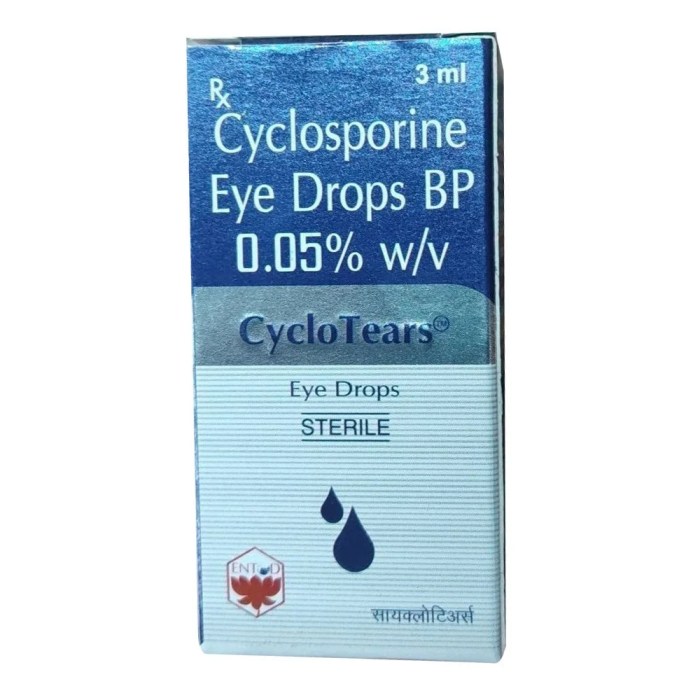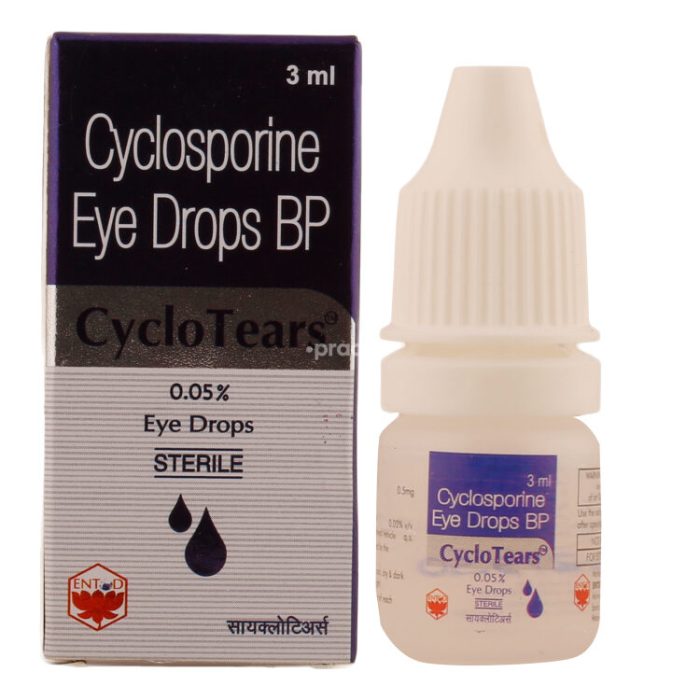Cyclosporine eye drops are a powerful tool in the treatment of various eye conditions. These drops work by suppressing the immune system in the eye, which helps to reduce inflammation and protect the delicate structures of the eye. Cyclosporine eye drops are available in different formulations, each designed to address specific needs.
Their mechanism of action involves inhibiting the production of certain proteins that contribute to inflammation. This targeted approach makes cyclosporine eye drops a valuable option for patients who have not responded well to traditional treatments.
What is Cyclosporine Eye Drops?

Cyclosporine eye drops are a type of medication used to treat various eye conditions, including dry eye disease, allergic conjunctivitis, and keratoconjunctivitis sicca. They are commonly prescribed to patients who experience discomfort, irritation, and vision problems due to dry eyes.
Mechanism of Action
Cyclosporine eye drops work by suppressing the immune system in the eye, reducing inflammation and promoting tear production. Cyclosporine is an immunosuppressant that specifically targets T lymphocytes, a type of white blood cell responsible for initiating immune responses. By inhibiting the activation and proliferation of T lymphocytes, cyclosporine reduces the inflammation that contributes to dry eye symptoms.
Types of Cyclosporine Eye Drops
There are different types of cyclosporine eye drops available, formulated for various applications and strengths. The most common types include:
- Restasis (cyclosporine 0.05%): This is the original formulation of cyclosporine eye drops and is widely used for the treatment of dry eye disease.
- Cequa (cyclosporine 0.09%): This formulation contains a higher concentration of cyclosporine and is designed for patients who do not respond well to Restasis.
- Xiidra (lifitegrast 5%): This is another type of eye drop that works by suppressing the immune system, but it targets a different type of cell called T cells. Xiidra is also used to treat dry eye disease.
Chemical Structure
Cyclosporine is a cyclic polypeptide with a complex chemical structure. It consists of 11 amino acids arranged in a ring-like structure. The molecule contains several functional groups, including hydroxyl, amide, and carbonyl groups, which contribute to its immunosuppressive activity.
The chemical formula of cyclosporine is C62H111N11O12.
Medical Uses of Cyclosporine Eye Drops

Cyclosporine eye drops are a type of medication used to treat various eye conditions, primarily those related to inflammation and immune system dysfunction. These drops work by suppressing the immune system, thereby reducing inflammation and its associated symptoms.
Treatment of Dry Eye Disease
Dry eye disease occurs when the eyes do not produce enough tears or when the tears evaporate too quickly. This can cause discomfort, irritation, and blurred vision. Cyclosporine eye drops are effective in treating dry eye disease by promoting tear production and reducing inflammation.
Cyclosporine eye drops are often used for dry eye disease when other treatments, such as artificial tears, have not been successful.
Treatment of Keratoconjunctivitis Sicca (KCS)
Keratoconjunctivitis sicca (KCS) is a severe form of dry eye disease. It is characterized by chronic inflammation and damage to the cornea and conjunctiva, the transparent outer layer of the eye. Cyclosporine eye drops can help manage KCS by reducing inflammation and promoting tear production.
Cyclosporine eye drops are a common treatment for KCS, particularly in cases where other treatments have not been effective.
Treatment of Vernal Keratoconjunctivitis (VKC)
Vernal keratoconjunctivitis (VKC) is a severe allergic eye condition that affects primarily children and young adults. It is characterized by intense itching, redness, and swelling of the eyes. Cyclosporine eye drops can help manage VKC by reducing inflammation and controlling allergic reactions.
Cyclosporine eye drops are a valuable treatment option for VKC, especially when other treatments have not provided sufficient relief.
Treatment of Atopic Keratoconjunctivitis (AKC)
Atopic keratoconjunctivitis (AKC) is a chronic allergic eye condition that affects people with atopic dermatitis, a skin condition characterized by eczema and other allergic reactions. AKC is characterized by chronic inflammation and itching of the eyes. Cyclosporine eye drops can help manage AKC by reducing inflammation and controlling allergic reactions.
Cyclosporine eye drops are an effective treatment for AKC, particularly when other treatments have not been successful.
Administration and Dosage

Cyclosporine eye drops are typically administered by instilling one drop into the affected eye(s) at a specific frequency. The exact dosage and frequency will vary depending on the individual’s condition and the specific formulation of cyclosporine being used.
Proper Administration
To properly administer cyclosporine eye drops, follow these steps:
- Wash your hands thoroughly with soap and water before handling the eye drops.
- Tilt your head back slightly and look upwards.
- Gently pull down the lower eyelid to create a small pouch.
- Hold the dropper bottle directly over the eye and squeeze out one drop into the pouch.
- Close your eye for a few seconds to allow the drop to spread evenly.
- Gently press a clean tissue or cotton ball against the inner corner of the eye to absorb any excess drops.
- Avoid touching the tip of the dropper to your eye or any other surface.
Recommended Dosage and Frequency
The recommended dosage and frequency of cyclosporine eye drops will vary depending on the individual’s condition and the specific formulation being used.
- For dry eye disease, the typical dosage is one drop in each affected eye two to four times daily.
- For other conditions, such as keratoconjunctivitis sicca, the dosage may be different.
It is crucial to follow your doctor’s instructions carefully and to use the eye drops exactly as prescribed.
Potential Risks and Side Effects
Like all medications, cyclosporine eye drops can cause side effects. Some common side effects include:
- Burning or stinging sensation in the eye.
- Redness or irritation of the eye.
- Blurred vision.
- Headache.
- Eye discharge.
In rare cases, cyclosporine eye drops can cause more serious side effects, such as:
- Increased eye pressure.
- Infection.
- Allergic reactions.
If you experience any serious side effects, stop using the eye drops and contact your doctor immediately.
Cyclosporine eye drops are a common treatment for dry eye disease, which can be quite uncomfortable. While they help to reduce inflammation and improve tear production, some individuals may also experience side effects. If you’re concerned about potential side effects, you might want to consult with your doctor about alternative treatments. For instance, they might suggest medications like concerta 18 mg , which are often prescribed for attention-deficit/hyperactivity disorder (ADHD).
However, it’s important to remember that cyclosporine eye drops are a safe and effective treatment for many people, and the benefits often outweigh the risks.
Interactions and Precautions: Cyclosporine Eye Drops
Cyclosporine eye drops can interact with other medications and may pose risks for individuals with certain medical conditions. It’s crucial to understand these interactions and precautions to ensure safe and effective use of the medication.
Potential Drug Interactions
Drug interactions occur when the effects of one medication are altered by another. These interactions can either enhance or diminish the effects of the medication, potentially leading to adverse reactions. Here are some potential drug interactions with cyclosporine eye drops:
- Other immunosuppressants: Using cyclosporine eye drops with other immunosuppressants, such as tacrolimus or pimecrolimus, can increase the risk of side effects, particularly those related to the immune system. This is because both medications suppress the immune system, potentially leading to a heightened risk of infections or other complications.
- Antibiotics: Certain antibiotics, such as erythromycin or clarithromycin, can increase the concentration of cyclosporine in the body. This can lead to an increased risk of side effects, especially those related to the liver or kidneys.
- Antivirals: Some antiviral medications, such as ritonavir or saquinavir, can also increase the concentration of cyclosporine in the body. This can increase the risk of side effects, including liver and kidney problems.
- Calcium channel blockers: Medications that block calcium channels, such as verapamil or diltiazem, can increase the concentration of cyclosporine in the body, potentially leading to an increased risk of side effects.
Precautions, Cyclosporine eye drops
Precautions are specific measures taken to minimize the risk of adverse effects or complications. When using cyclosporine eye drops, it’s essential to follow these precautions:
- Contact lens wear: Cyclosporine eye drops should not be used while wearing contact lenses. The medication can accumulate under the lenses, potentially leading to irritation or infection.
- Driving and operating machinery: Cyclosporine eye drops can cause blurred vision, especially immediately after application. Avoid driving or operating machinery until your vision has cleared.
- Pregnancy and breastfeeding: It’s essential to consult your doctor if you are pregnant or breastfeeding before using cyclosporine eye drops. The medication can potentially pass into breast milk and may affect the developing fetus.
- Eye infections: If you have an active eye infection, do not use cyclosporine eye drops until the infection has cleared. Using the medication during an infection could worsen the condition.
Risks for Individuals with Specific Medical Conditions
Individuals with certain medical conditions may be at increased risk of experiencing adverse effects from cyclosporine eye drops. These conditions include:
- Liver disease: Individuals with liver disease may have difficulty metabolizing cyclosporine, potentially leading to an increased risk of side effects.
- Kidney disease: Cyclosporine can be toxic to the kidneys. Individuals with kidney disease may be at increased risk of kidney damage when using this medication.
- High blood pressure: Cyclosporine can increase blood pressure. Individuals with high blood pressure should monitor their blood pressure closely while using this medication.
- Diabetes: Cyclosporine can affect blood sugar levels. Individuals with diabetes should monitor their blood sugar closely while using this medication.
Storage and Handling
Proper storage and handling of cyclosporine eye drops are crucial to maintain their effectiveness and ensure safe use. These steps help prevent contamination and degradation of the medication, ensuring its potency and safety for your eyes.
Storage Conditions
Storing cyclosporine eye drops correctly is vital for preserving their effectiveness. Here’s how to do it:
- Store the eye drops at room temperature, between 15°C and 30°C (59°F and 86°F).
- Keep the bottle tightly closed when not in use to prevent contamination and evaporation.
- Avoid storing the eye drops in direct sunlight or extreme temperatures, as this can affect their stability.
- Do not freeze the eye drops, as this can damage the medication.
Handling Procedures
- Wash your hands thoroughly with soap and water before handling the eye drops.
- Avoid touching the tip of the dropper to your eye or any other surface to prevent contamination.
- After each use, replace the cap tightly to prevent contamination and maintain the sterility of the solution.
- Discard the eye drops after the expiration date printed on the bottle, as they may become ineffective or potentially harmful.
Importance of Discarding Expired Eye Drops
Expired cyclosporine eye drops can lose their effectiveness and may contain harmful bacteria. Using expired eye drops can lead to eye infections or other complications. Always check the expiration date on the bottle and discard the eye drops once they expire.
Cyclosporine eye drops offer a promising treatment option for individuals facing eye conditions. Their ability to target inflammation and promote healing makes them a valuable addition to the medical toolkit. As research continues, we can expect to see further advancements in the development of cyclosporine eye drops, potentially leading to even more effective and personalized treatment strategies for eye health.